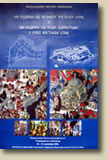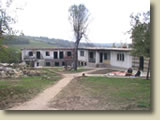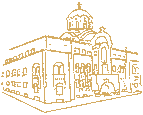|
Information
Service of
the Serbian Orthodox Church
November 15, 2004

THEOLOGICAL
SYMPOSIUM
AT ORTHODOX THEOLOGICAL FACULTY
OF BELGRADE UNIVERSITY
 The
Orthodox Theological Faculty of Belgrade University organized
an international theological symposium on November 18-19, 2004.
The theme of the symposium is two historical events: the 950th
anniversary of the Great Schism (1054 A.D.) and the 800th anniversary
of the fall of Constantinople to the Crusaders (1204). The
Orthodox Theological Faculty of Belgrade University organized
an international theological symposium on November 18-19, 2004.
The theme of the symposium is two historical events: the 950th
anniversary of the Great Schism (1054 A.D.) and the 800th anniversary
of the fall of Constantinople to the Crusaders (1204).
Symposium
schedule:
On
Thursday, November 18, 2004 after morning services, the opening
ceremony will take place at 9:00 a.m. in the amphitheater of the
Theological Faculty. The dean of the Theological Faculty and His
Holiness Serbian Patriarch Pavle will make introductory remarks.
Speakers
during the first working session will be Bishop Dr. Atanasije
Jevtic (Years of crisis, 1054-1204), Dr. Jure Zecevic (Fortieth
anniversary of the removal of the anathema of 1054), Dr. Bogdan
Dolenc (Difference between universal and eucharistic ecclesiology:
Two approaches to the unification of the two Churches), followed
by open discussion. The second work session will begin with Dr.
Radivoj Radic (The divided Empire: Byzantium on the eve of 1204),
followed by Dr. Ljubomir Maksimovic (Serbia and the consequences
of the Fourth Crusade) and Dr. Mirjana Zivojinovic (Athos circa
1204). The first working day will conclude with discussion on
these topics.
On
Friday, November 19, 2004, the third working session will begin
with Dr. Jovan Tarnanidis (The autocephaly of the Serbian and
Bulgarian Churches in the diplomatic plans of Emperor Michael
VIII the Paleologist and the Unionist conference in Lyon), followed
by Dr. Milos Antonovic (Serbia and the Lyonese Union, 1274), Dr.
Andrija Veselinovic (The fall of Constantinople in Serbian history),
followed by discussion. The symposium will conclude at 12:00 noon
and a summary and conclusion from this theological conference
will be presented during the closing ceremony.
The
committee for preparation and organization of the symposium, which
is comprised of Protopresbyter Professor Dr. Radomir V. Popovic,
Protopresbyter Professor Dr. Predrag Puzovic, Assistant Professor
Dr. David Perovic, Assistant Lecturer Dr. Dragana Janjic and Assistant
Trainee Vladislav Puzovic, invite all those interested to take
part in this interesting thematic gathering.
The
organizer and sponsor of the Symposium and the anthology from
the Symposium is the Ministry for Religions of the Republic of
Serbia.

FEAST
OF STS COSMAS AND DAMIAN CELEBRATED
On
the feast of Sts. Cosmas and Damian (the Holy Unmercenary Physicians),
the first patron saint's day of Zociste Monastery since the recent
return of the monks to the burned ruins of this holy shrine was
celebrated.
 Due
to heavy rain Bishop Teodosije of Lipljan and the clergy and monastics
of the Diocese of Raska-Prizren and Kosovo-Metohija served Holy
Hierarchal Liturgy in the nearby Serb village of Velika Hoca in
the church of the Holy Protomartyr and Archdeacon Stefan. Several
hundred faithful attended Holy Liturgy and the festive luncheon
prepared by the monks of Zociste and the faithful of Hoca. In
addition to Serbs from Velika Hoca and Orahovac, Serbs from the
Metohija enclaves of Bicha and Osojani, from the north of Kosovo
and an entire busload of faithful from Valjevo came with KFOR
escorts. Due
to heavy rain Bishop Teodosije of Lipljan and the clergy and monastics
of the Diocese of Raska-Prizren and Kosovo-Metohija served Holy
Hierarchal Liturgy in the nearby Serb village of Velika Hoca in
the church of the Holy Protomartyr and Archdeacon Stefan. Several
hundred faithful attended Holy Liturgy and the festive luncheon
prepared by the monks of Zociste and the faithful of Hoca. In
addition to Serbs from Velika Hoca and Orahovac, Serbs from the
Metohija enclaves of Bicha and Osojani, from the north of Kosovo
and an entire busload of faithful from Valjevo came with KFOR
escorts.
On
behalf of Bishop Artemije, Bishop Teodosije greeted the faithful
who gathered in great number despite difficult security conditions
and bad weather. He had special words of encouragement for Protosingel
Petar and his brethren who "came at a difficult time to a
difficult place with firm faith and hope in God's help in restoring
life in this ancient holy shrine and in rising Zociste Monastery
again from the ashes". Bishop Teodosije also thanked members
of KFOR who supported the return of the monks and who are currently
protecting the monastery.
The
monastery of Sts. Cosmas and Damian (the Unmercenary Physicians)
in Zociste was built in the 14th century. It is mentioned for
the first time in the charter of the Holy King Stefan of Decani
from 1327. The Holy King turned over the monastery and surrounding
land for the use of the Serbian monastery of Chilandar on the
Holy Mountain of Athos as its monastery metoh, or estate. The
church and monks' quarters were destroyed many times throughout
history. In summer 1999 Albanian extremists completely destroyed
the church with its remnants of frescoes dating back to the 14th
century, and set fire to the monks' quarters. Since then until
one month ago the monastery was abandoned because the monks were
prevented from returning. Thanks to efforts on the part of KFOR
representatives and the agreement of local municipal authorities,
a brotherhood of three monks returned headed by Protosingel Petar,
the administrator of the monastery of Djurdjevi Stupovi (the Pillars
of St. George) and the former abbot of Zociste Monastery before
the war.

METROPOLITAN
KIRILL OF SMOLENSK AND KALINGRAD ADDRESSES EUROPEAN COUNCIL OF
RELIGIOUS LEADERS ON KOSOVO AND METOHIJA
Speech
at the meeting of the European Council of Religious Leaders and
Religious Leaders of Kosovo, Leuven (Belgium), 8 November 2004
His
Eminence Metropolitan Kirill of Smolensk and Kaliningrad, the
chairman of the Section for External Church Relations of the Moscow
Patriarchate, took part in the regular meeting of the European
Council of Religious Leaders and religious leaders of Kosovo which
took place in Leuven, Belgium, on November 7, 2004.
On
the first day of the meeting Metropolitan Kirill, who is one of
the comoderators of the European Council of Religious Leaders,
chaired an open session of the Council and a discussion on problems
in Kosovo and Metohija, which involved participation by members
of the diplomatic corps and international organizations.
In
his introductory remarks, Metropolitan Kirill spoke as follows:
“First of all I would like to thank all those who work for the
establishment of peace in the Balkans. The contradictions, which
are rooted in the distant past, have become worse in the region
and led to wars and conflicts in the recent years. There is no
great bloodshed in the Balkans at present, and great service to
this situation was rendered by many states and international organizations.
However, it were the Balkan nations themselves who ‘guided their
feet into the way of peace’ largely thanks to the preaching of
the religious leaders who have called people to peace and tried
to stop violence.
“Having
said this, I cannot help drawing your attention to the tragic
and alarming aspects of the situation. Unfortunately, peace in
the Balkans, and in Kosovo in particular, is neither complete,
nor just. Many people are dying or are being expelled from their
land, the ancient holy places are barbarously destroyed, and the
return of the considerable number of refugees is still out of
the question.
“An
attempt to justify the foreign military intervention was reduced
to the idea of the defense of a national minority. We were promised
an ethnical peace and multicultural society under the control
of the international military contingent with the assistance of
international civil personal. Yet, people still suffer – this
time the Serbian population of Kosovo.
“As
a result, a wall of mutual distrust between the Serbs and Albanians
in Kosovo has grown to inconceivable dimensions, while the responsible
persons do not try to radically change the situation.
“The
present relations among people in Kosovo show that the world community
actually recognizes ‘the right of the might’ and cannot do anything
to restore justice. It is not fortuitous that we hear the appeals
to radical division of the territories, where the Serbs and Albanians
reside. The rigid ethno-territorial division becomes the outcome
of conflicts both in the Balkans in general, including Bosnia,
and in the regions of the Middle East and the Armenian-Azerbaijanian
conflicts, as well as in some African countries.
“We
hear about the ability of the world community to settle conflicts
by bringing people to peaceful coexistence, However, practice
shows that the establishment of the monoethnic territories, divided
by frontiers and walls, sometimes gives real guaranties of security.
“Moreover,
the most powerful countries of the word de facto recognize military
victories of one party in a conflict, and sometimes assist the
achievement of these victories. All this puts into serious doubt
the existing standards of law, the very principle of justice,
and the idea of building a multicultural society. Some people
even say that this idea failed. Yet we cannot and should not turn
down the ideals of justice and lawfulness by making world politics
a domain of the ‘right of the might’.
“The
situation in Kosovo should become a litmus paper by which the
world will see whether we are ready to implement the best moral
ideals, or whether humanity is receding into the law of the jungle.
“The
world community should stop the suffering of the Serbs in Kosovo
as well as of any other nation. May I express my hope that we,
politicians, international and religious leaders, will be able
to bring about a lasting peace in this region through our common
work, as the way of injustice, hatred and violence will never
lead to any real settlement of the conflict.”
From
the site of the Russian Orthodox Church Representation to the
European Institutions, www.orthodoxeurope.org

ICON
PAINTING IN SERBIA TODAY
On
November 11, 2004 an exhibition of icons entitled “Icon Painting
in Serbia Today” opened in the Russian Cultural Center in Bratislava
featuring works by icon painters Vladimir Cetkovic, Boban Veljkovic
and Veronika Djukanovic. Jan Zozulak, a professor at the Orthodox
Faculty in Preshov, opened the exhibition and spoke about the
significance and value of icons, especially those from Serbia,
which are most faithful in adhering to the Byznatine tradition
of icon painting. Exhibits are available for purchase and a part
of the proceeds will be set aside to complete work on the Orthodox
church of St. Rastislav currently being built in Bratislava. The
exhibition will be open until the end of November, when it will
move to Vienna.
The
opening of the exhibition received good media coverage, and the
first program of Polish television made a feature-length film
regarding the exhibition, and the significance and importance
of iconography in the Orthodox Church.

[Serbian
Translation Services]

Copyright © 1999-2004 by
The Information Service of
the Serbian Orthodox Church
11000 Belgrade
Kralja Petra I no.5
+381 11 3282 596
e-mail
|

